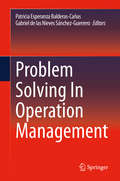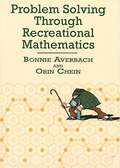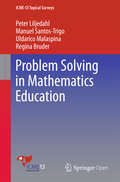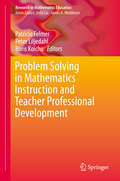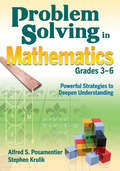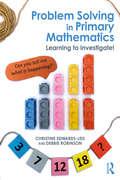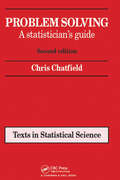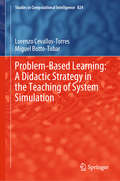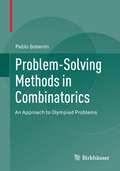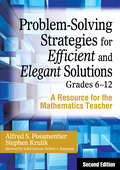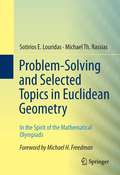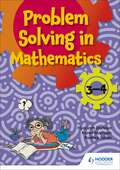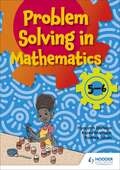- Table View
- List View
Problem Solving In Operation Management
by Patricia Esperanza Balderas-Cañas Gabriel de las Nieves Sánchez-GuerreroThis volume examines problem solving and applied systems aimed at improving performance and management of organizations. The book’s eight chapters are integrated into two parts: methodologies and techniques that discuss complex dynamic analysis of the organizations, participative processes for building trend scenarios, consultancy as a systemic intervention process, processes to promote innovative goals in organizations, and analytical processes and solid mathematical representation systems. The authors also include a model to urban parks location, an analytic model to urban services location, and a system to forecast demand with fussy sets.Describes methodologies to analyze processes in complex dynamic organizations, including as participative, interventional, innovative, and analytical approaches;Clarifies a strategies for providing structure to complex organizations and applying analytical methods to decision making;Illustrates problem holistic solving strategies;Explains how to approach several problems from a holistic point of view and how analyze the subjacent processes to make decisions.
Problem Solving Through Recreational Mathematics
by Bonnie Averbach Orin CheinHistorically, many of the most important mathematical concepts arose from problems that were recreational in origin. This book takes advantage of that fact, using recreational mathematics -- problems, puzzles and games -- to teach students how to think critically. Encouraging active participation rather than just observation, the book focuses less on mathematical results than on how these results can be applied to thinking about problems and solving them. Each chapter contains a diverse array of problems in such areas as logic, number and graph theory, two-player games of strategy, solitaire games and puzzles, and much more. Sample problems (solved in the text) whet readers' appetites and motivate discussions; practice problems solidify their grasp of mathematical ideas; and exercises challenge them, fostering problem-solving ability. Appendixes contain information on basic algebraic techniques and mathematical inductions, and other helpful addenda include hints and solutions, plus answers to selected problems. An extensive appendix on probability is new to this Dover edition.
Problem Solving and Data Analysis Using Minitab: A Clear and Easy Guide to Six Sigma Methodology
by Rehman M. KhanSix Sigma statistical methodology using Minitab Problem Solving and Data Analysis using Minitab presents example-based learning to aid readers in understanding how to use MINITAB 16 for statistical analysis and problem solving. Each example and exercise is broken down into the exact steps that must be followed in order to take the reader through key learning points and work through complex analyses. Exercises are featured at the end of each example so that the reader can be assured that they have understood the key learning points. Key features: Provides readers with a step by step guide to problem solving and statistical analysis using Minitab 16 which is also compatible with version 15. Includes fully worked examples with graphics showing menu selections and Minitab outputs. Uses example based learning that the reader can work through at their pace. Contains hundreds of screenshots to aid the reader, along with explanations of the statistics being performed and interpretation of results. Presents the core statistical techniques used by Six Sigma Black Belts. Contains examples, exercises and solutions throughout, and is supported by an accompanying website featuring the numerous example data sets. Making Six Sigma statistical methodology accessible to beginners, this book is aimed at numerical professionals, students or academics who wish to learn and apply statistical techniques for problem solving, process improvement or data analysis whilst keeping mathematical theory to a minimum.
Problem Solving in Mathematics Education
by Peter Liljedahl Regina Bruder Manuel Santos-Trigo Uldarico MalaspinaThis survey book reviews four interrelated areas: (i) the relevance of heuristics in problem-solving approaches why they are important and what research tells us about their use; (ii) the need to characterize and foster creative problem-solving approaches what type of heuristics helps learners devise and practice creative solutions; (iii) the importance that learners formulate and pursue their own problems; and iv) the role played by the use of both multiple-purpose and ad hoc mathematical action types of technologies in problem-solving contexts what ways of reasoning learners construct when they rely on the use of digital technologies, and how technology and technology approaches can be reconciled. "
Problem Solving in Mathematics Instruction and Teacher Professional Development (Research in Mathematics Education)
by Peter Liljedahl Patricio Felmer Boris KoichuRecent research in problem solving has shifted its focus to actual classroom implementation and what is really going on during problem solving when it is used regularly in classroom. This book seeks to stay on top of that trend by approaching diverse aspects of current problem solving research, covering three broad themes. Firstly, it explores the role of teachers in problem-solving classrooms and their professional development, moving onto—secondly—the role of students when solving problems, with particular consideration of factors like group work, discussion, role of students in discussions and the effect of students’ engagement on their self-perception and their view of mathematics. Finally, the book considers the question of problem solving in mathematics instruction as it overlaps with problem design, problem-solving situations, and actual classroom implementation. The volume brings together diverse contributors from a variety of countries and with wide and varied experiences, combining the voices of leading and developing researchers. The book will be of interest to any reader keeping on the frontiers of research in problem solving, more specifically researchers and graduate students in mathematics education, researchers in problem solving, as well as teachers and practitioners.
Problem Solving in Mathematics, Grades 3-6: Powerful Strategies to Deepen Understanding
by Alfred S. Posamentier Stephen KrulikWith sample problems and solutions, this book demonstrates how teachers can incorporate nine problem solving strategies into any mathematics curriculum to help students succeed.
Problem Solving in Primary Mathematics: Learning to Investigate!
by Debbie Robinson Christine Edwards-LeisProblem Solving in Primary Mathematics is an essential text designed to support new and experienced teachers in guiding pupils through mathematical investigations and problem solving, offering a framework that children themselves can begin to adopt as they progress to greater metacognitive awareness. Underpinned by the latest international research and theory, it examines how individual pupils think and act differently and offers guidance on how to promote independence and autonomy in the classroom. It examines key topics such as: Preparing for mathematical learning Designing learning material Assessing and evaluating learning Identifying key points for intervention What to do when learning is stalled Critical numeracy for real-world problem solving Mental Model Theory and the Mental Model Mode Different approaches to problem solving and investigating Aimed at new and experienced educators, particularly those with a maths specialism, and illustrated with investigations and activities, Problem Solving in Primary Mathematics demonstrates how frameworks can be used in key mathematical areas and assists students in progressing towards more meaningful problem solving.
Problem Solving: A statistician's guide, Second edition (Chapman & Hall/CRC Texts in Statistical Science)
by Chris ChatfieldThis book illuminates the complex process of problem solving, including formulating the problem, collecting and analyzing data, and presenting the conclusions.
Problem-Based Learning: A Didactic Strategy in the Teaching of System Simulation (Studies in Computational Intelligence #824)
by Miguel Botto-Tobar Lorenzo Cevallos-TorresThis book describes and outlines the theoretical foundations of system simulation in teaching, and as a practical contribution to teaching-and-learning models. It presents various methodologies used in teaching, the goal being to solve real-life problems by creating simulation models and probability distributions that allow correlations to be drawn between a real model and a simulated model. Moreover, the book demonstrates the role of simulation in decision-making processes connected to teaching and learning.
Problem-Solving Methods in Combinatorics
by Pablo SoberónEvery year there is at least one combinatorics problem in each of the major international mathematical olympiads. These problems can only be solved with a very high level of wit and creativity. This book explains all the problem-solving techniques necessary to tackle these problems, with clear examples from recent contests. It also includes a large problem section for each topic, including hints and full solutions so that the reader can practice the material covered in the book. The material will be useful not only to participants in the olympiads and their coaches but also in university courses on combinatorics.
Problem-Solving Strategies for Efficient and Elegant Solutions, Grades 6-12: A Resource for the Mathematics Teacher
by Alfred S. Posamentier Stephen KrulikThis updated edition presents ten strategies for solving a wide range of mathematics problems, plus new sample problems.
Problem-Solving and Selected Topics in Euclidean Geometry
by Michael Th. Rassias Sotirios E. Louridas"Problem-Solving and Selected Topics in Euclidean Geometry: in the Spirit of the Mathematical Olympiads" contains theorems which are of particular value for the solution of geometrical problems. Emphasis is given in the discussion of a variety of methods, which play a significant role for the solution of problems in Euclidean Geometry. Before the complete solution of every problem, a key idea is presented so that the reader will be able to provide the solution. Applications of the basic geometrical methods which include analysis, synthesis, construction and proof are given. Selected problems which have been given in mathematical olympiads or proposed in short lists in IMO's are discussed. In addition, a number of problems proposed by leading mathematicians in the subject are included here. The book also contains new problems with their solutions. The scope of the publication of the present book is to teach mathematical thinking through Geometry and to provide inspiration for both students and teachers to formulate "positive" conjectures and provide solutions.
Problem-solving 3-4
by Karen Morrison Hyacinth Dorleon Rodney JulienWe live in an increasingly technological and information-rich world. Education is focusingmore on enquiry and skills-based approaches. Students, even at the early levels ofschooling, are expected to develop a range of skills, including problem solving skills.Creative thinking, using information appropriately and problem solving are important for students in the school curriculum and in daily life. This book will help students learn how to apply mathematical skills in different contexts and explain how they got to their solutions.This book is easy for parents and teachers to use, and teaches multiple strategies forsolving problems, using challenging but supportive contexts. The approach is underpinnedby the Five E's approach to learning.The course will help student to:· Engage with problems meaningfully· Explore different options for approaching and solving problems· Explain how they are thinking· Elaborate on their working and processes and see connections between different areasof mathematics· Evaluate what worked and what didn't, learning from mistakes as well as successes
Problem-solving 5-6
by Karen Morrison Hyacinth Dorleon Rodney JulienWe live in an increasingly technological and information-rich world. Education is focusingmore on enquiry and skills-based approaches. Students, even at the early levels ofschooling, are expected to develop a range of skills, including problem solving skills.Creative thinking, using information appropriately and problem solving are important for students in the school curriculum and in daily life. This book will help students learn how to apply mathematical skills in different contexts and explain how they got to their solutions.This book is easy for parents and teachers to use, and teaches multiple strategies forsolving problems, using challenging but supportive contexts. The approach is underpinnedby the Five E's approach to learning.The course will help student to:· Engage with problems meaningfully· Explore different options for approaching and solving problems· Explain their thought processes · Elaborate on their working and processes and see connections between different areasof mathematics· Evaluate what worked and what didn't, learning from mistakes as well as successes
Problem-solving K-2
by Karen Morrison Hyacinth Dorleon Rodney JulienWe live in an increasingly technological and information-rich world. Education is focusing more on enquiry and skills-based approaches. Students, even at the early levels of schooling, are expected to develop a range of skills, including problem solving skills. Creative thinking and problem solving are not only important elements in the curriculum but they are also crucial in daily life. Students need to learn basic mathematical skills, but they also have to be able to apply these in unfamiliar contexts, communicate their thinking and explain how they got to their solutions. This book is easy for parents and teachers to use, and teaches multiple strategies for solving problems, using challenging but supportive contexts. The approach is underpinned by the Five E's approach to learning. The course will help student to: · Engage with problems meaningfully · Explore different options for approaching and solving problems· Explain how they are thinking· Elaborate on their working and processes and see connections between different areas of mathematics· Evaluate what worked and what didn't, learning from mistakes as well as successes.
Problembasiertes Lernen im Mathematikunterricht der Grundschule: Entwicklung und Evaluation des Unterrichtskonzepts ELIF (Hildesheimer Studien zur Mathematikdidaktik)
by Sandra Strunk Julia WichersELIF (Eigenständige Lernzielentwicklung und Inhaltserschließung am Fall) ist eine Unterrichtskonzeption, die ausgehend vom Problembasierten Lernen theoriebasiert entwickelt und mithilfe mehrerer Design-Based Research-Zyklen an die Anforderungen der Praxis angepasst wurde. Die Schüler entwickeln auf Grundlage eines Falls inhaltliche Lernziele in Form von Lernfragen, die sie sich selbstständig in individuellen und kooperativen Arbeitsphasen erarbeiten. Damit soll insbesondere die Fähigkeit zur selbstständigen Lebensbewältigung durch eine stärkere Anwendungs- und Schülerorientierung des Unterrichts gefördert werden.
Probleme der Statistik und Prozessanalyse mit Excel lösen: Ein praktischer Ratgeber zum Buch "Methoden der Statistik und Prozessanalyse"
by Yuri A.W. Shardt Carsten GatermannDieser praktische Ratgeber zum Buch „Methoden der Statistik und Prozessanalyse – Eine anwendungsorientierte Einführung“ gibt einen kompakten Überblick über die Nutzung von Excel zur Lösung typischer statistischer Fragestellungen. Neben kurzen Theorieteilen liegt der Fokus des Buchs auf detailliert dargestellten Excel Beispiele zur Lösung der Aufgaben. Weiterhin werden typische Abläufe für Standardaufgaben in Excel vorgestellt und erklärt. Kontrollfragen am Ende jedes Kapitels ermöglichen dem Lesenden, das erworbene Wissen selbstständig zu testen.
Problemlösen in der Mathematik: Ein heuristischer Werkzeugkasten
by Wolfgang SchwarzErinnern Sie sich an eine Alltagssituation, in der es Ihnen gelungen ist, aus einem Problem eine Aufgabe zu machen, die Sie erfolgreich bewältigen konnten? Und haben Sie dabei vom Einsatz geeigneter Werkzeuge profitiert? Solche Szenarien prägen den beruflichen Alltag aller Studierenden mathematischer Fachrichtungen. Man sieht sich permanent mit mathematischen Problemen konfrontiert, zu deren Lösung es einer guten Idee bedarf; oft findet man diese aber nicht, weil man sich der Werkzeuge nicht bewusst ist, mit denen man die Lösungsidee freilegen kann. Dieses Buch soll hier Abhilfe schaffen. Anhand von ca. 70 Beispielen aus der Diskreten Mathematik, der Arithmetik, der Zahlentheorie, der Stochastik, der Geometrie, der Linearen Algebra, der reellen Analysis, der Funktionentheorie, der Kombinatorik und der Mathematikgeschichte wird eine umfangreiche Auswahl heuristischer Vorgehensweisen erläutert, denen die Rolle des Werkzeugs in Problemlöseprozessen zufällt. Die heuristischen Strategien des Problemlösens werden strukturell systematisiert und nach Möglichkeit prozessual den verschiedenen Phasen des Problemlöseprozesses nach Pólya zugeordnet; dadurch entsteht nicht nur Ordnung im heuristischen Werkzeugkasten, sondern auch eine Verfeinerung des Pólya'schen Phasenmodells des Problemlösens.
Problemlösen mit Strategieschlüsseln: Eine explorative Studie zur Unterstützung von Problembearbeitungsprozessen bei Dritt- und Viertklässlern (Essener Beiträge zur Mathematikdidaktik)
by Raja Herold-BlasiusLernhilfen in Form von Hilfe- oder auch Tippkarten werden als Material zur Differenzierung im Unterricht eingesetzt. Ob diese Lernenden tatsächlich helfen, ist bisher unzureichend geklärt. Für die vorliegende Untersuchung dienen sog. Strategieschlüssel als Interventionsinstrument. Theoretisch ist zu vermuten, dass die Schlüssel den Einsatz von Strategien triggern und die Selbstregulation im Bearbeitungsprozess anregen. Im Kontext des mathematischen Problemlösens wird untersucht, auf welche Art und Weise die Strategieschlüssel den Problembearbeitungsprozess von Dritt- bis Viertklässlern beeinflussen. Die quantitativen Analysen ergeben einen statistisch hoch signifikanten Zusammenhang zwischen der Interaktion mit den Strategieschlüsseln, dem Heurismeneinsatz und dem Wechsel zwischen Episoden im Problembearbeitungsprozess. Die qualitativen Analysen zeigen, dass die Strategieschlüssel auf neun verschiedene Weisen genutzt werden, der Einsatz von Heurismen durch sie getriggert wird und dass selbstregulatorische Tätigkeiten angeregt werden. Bei der Verwendung der Strategieschlüssel werden neun Muster identifiziert.
Problemlösen: Begriff – Strategien – Einflussgrößen – Unterricht – (häusliche) Förderung
by Ulrike KipmanProblemlösen gilt als eine der Schlüsselqualifikationen des 21. Jahrhunderts. Es geht beim Problemlösen nicht nur darum, Informationen sinnvoll zu vernetzen, dynamisch in Beziehung zu setzen, Wahrscheinlichkeiten zu berechnen und eine Kette richtiger Entscheidungen zu treffen, sondern auch vielfach darum, eine Vielzahl an Außenkriterien zu berücksichtigen und ein entsprechendes „Weltwissen“ an den Tag zu legen. Dieses Buch soll die Frage beantworten, wie man zu einem guten Problemlöser / einer guten Problemlöserin werden kann bzw. warum bestimmte Personen bei der Lösung von Problemen erfolgreicher sind als andere. Nach einer umfassenden Zusammenstellung der Literatur zu diesem Thema werden Einflussgrößen auf das Problemlösen analysiert und miteinander abgeglichen und Ideen für den Unterricht in der Primarstufe und Sekundarstufe I präsentiert. Zudem werden verschiedene Arten des Unterrichts im Hinblick auf die Wirksamkeit für unterschiedliche Personengruppen diskutiert, dies vor dem Hintergrund, dass nicht nur Problemstellungen stark variieren sondern auch die Problemlöser/innen. Eine Handreichung mit Brettspielen, die die Kriterien des Problemlösens erfüllen, ist ebenfalls Teil dieses Buches. Letztendlich wird ein Modell vorgeschlagen, welches erfolgreiches Problemlösen vielschichtig zu erklären versucht.
Problemlösen: Begriff – Strategien – Einflussgrößen – Unterricht – (häusliche) Förderung
by Ulrike KipmanProblemlösen gilt als eine der Schlüsselqualifikationen des 21. Jahrhunderts. Es geht beim Problemlösen nicht nur darum, Informationen sinnvoll zu vernetzen, dynamisch in Beziehung zu setzen, Wahrscheinlichkeiten zu berechnen und eine Kette richtiger Entscheidungen zu treffen, sondern auch vielfach darum, eine Vielzahl an Außenkriterien zu berücksichtigen und ein entsprechendes „Weltwissen“ an den Tag zu legen. Dieses Buch soll die Frage beantworten, wie man zu einem guten Problemlöser / einer guten Problemlöserin werden kann bzw. warum bestimmte Personen bei der Lösung von Problemen erfolgreicher sind als andere. Nach einer umfassenden Zusammenstellung der Literatur zu diesem Thema werden Einflussgrößen auf das Problemlösen analysiert und miteinander abgeglichen und Ideen für den Unterricht in der Primarstufe und Sekundarstufe I präsentiert. Zudem werden verschiedene Arten des Unterrichts im Hinblick auf die Wirksamkeit für unterschiedliche Personengruppen diskutiert, dies vor dem Hintergrund, dass nicht nur Problemstellungen stark variieren sondern auch die Problemlöser/innen. Eine Handreichung mit Brettspielen, die die Kriterien des Problemlösens erfüllen, ist ebenfalls Teil dieses Buches. Letztendlich wird ein Modell vorgeschlagen, welches erfolgreiches Problemlösen vielschichtig zu erklären versucht. In der 2. Auflage wurden alle Kapitel überarbeitet und an den neuesten Kenntnisstand zum Thema Problemlösen angepasst. Die Kapitel zur schulischen und häuslichen Förderung der Problemlösekompetenz wurden stark erweitert und es werden nun eine Vielzahl an neuen Aufgaben und Spielen präsentiert, die beim Fördern von Problemlösen eine wertvolle Unterstützung leisten können. Das Kapitel zur Kombinatorik wurde nach der Rückmeldung von Studierenden und Kollegen komplett umstrukturiert und ist nun verständlicher und übersichtlicher aufgebaut.
Problems and Examples in Differential Equations
by Piotr Biler Tadeusz NadziejaThis book presents original problems from graduate courses in pure and applied mathematics and even small research topics, significant theorems and information on recent results. It is helpful for specialists working in differential equations.
Problems and Methods of Econometrics: The Poincaré Lectures of Ragnar Frisch 1933 (Routledge Studies in the History of Economics)
by Ragnar FrischThe development of economics changed dramatically during the twentieth century with the emergence of econometrics, macroeconomics and a more scientific approach in general. One of the key individuals in the transformation of economics was Ragnar Frisch, professor at the University of Oslo and the first Nobel Laureate in economics in 1969. He was a co-founder of the Econometric Society in 1930 (after having coined the word econometrics in 1926) and edited the journal Econometrics for twenty-two years. The discovery of the manuscripts of a series of eight lectures given by Frisch at the Henri Poincaré Institute in March–April 1933 on The Problems and Methods of Econometrics will enable economists to more fully understand his overall vision of econometrics. This book is a rare exhibition of Frisch’s overview on econometrics and is published here in English for the first time. Edited and with an introduction by Olav Bjerkholt and Ariane Dupont-Kieffer, Frisch’s eight lectures provide an accessible and astute discussion of econometric issues from philosophical foundations to practical procedures. Concerning the development of economics in the twentieth century and the broader visions about economic science in general and econometrics in particular held by Ragnar Frisch, this book will appeal to anyone with an interest in the history of economics and econometrics.
Problems and Planning in Third World Cities (Routledge Revivals)
by Michael PacioneWhen this title was first published in 1981, growing concern for the future of cities and those who inhabited them, stimulated by trends in global urbanisation, had resulted in much emphasis being placed on a problem-solving approach to the study of the city. The chapters in this edited collection, a companion to Urban Problems and Planning in the Developed World (Routledge Revivals, 2013), consider the problems and planning activities in a number of cities across the world. Varied case-studies, including Mexico City, Bogota and Shanghai, reflect the differing economic, cultural and political regimes of the modern world and ensure the continued value of this comprehensive work.
Problems and Proofs in Numbers and Algebra
by Richard S. Millman Peter J. Shiue Eric Brendan KahnFocusing on an approach of solving rigorous problems and learning how to prove, this volume is concentrated on two specific content themes, elementary number theory and algebraic polynomials. The benefit to readers who are moving from calculus to more abstract mathematics is to acquire the ability to understand proofs through use of the book and the multitude of proofs and problems that will be covered throughout. This book is meant to be a transitional precursor to more complex topics in analysis, advanced number theory, and abstract algebra. To achieve the goal of conceptual understanding, a large number of problems and examples will be interspersed through every chapter. The problems are always presented in a multi-step and often very challenging, requiring the reader to think about proofs, counter-examples, and conjectures. Beyond the undergraduate mathematics student audience, the text can also offer a rigorous treatment of mathematics content (numbers and algebra) for high-achieving high school students. Furthermore, prospective teachers will add to the breadth of the audience as math education majors, will understand more thoroughly methods of proof, and will add to the depth of their mathematical knowledge. In the past, PNA has been taught in a "problem solving in middle school" course (twice), to a quite advanced high school students course (three semesters), and three times as a secondary resource for a course for future high school teachers. PNA is suitable for secondary math teachers who look for material to encourage and motivate more high achieving students.
